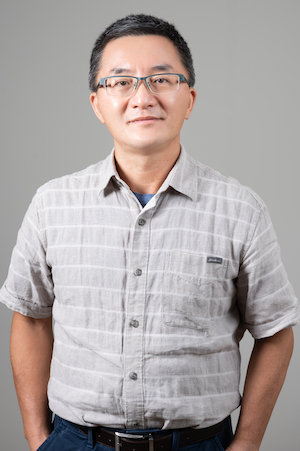Research
The research goal of my laboratory aims at unraveling the molecular mechanism underlying the stemness and differentiation of adult stem cells. Human placentas are composed of villous tissues, which harbor trophoblast stem (TS) cells capable of differentiating into multinucleate syncytiotrophoblasts (STBs) and migratory extravillous trophoblasts (EVTs). Indeed, placental cytotrophoblasts (CTBs) exhibit TS cell-like characteristics. GCM1 transcription factor is a master regulator for STB and EVT differentiation. GCM1 activity is positively and negatively regulated by cAMP and hypoxia signaling pathways, respectively. By manipulation of signaling pathways, we are able to establish trophoblast stem (TS) cells from CTBs. The placenta is the primary site of nutrient and gas exchange between mother and fetus. Placental dysfunction is associated with the pregnancy disorders preeclampsia (PE) and intrauterine growth retardation (IUGR). The undernourished fetuses due to dysfunctional placenta will have a higher risk of developing coronary heart disease, type 2 diabetes, stroke, and hypertension in their adulthood. We are currently working on (1) the upstream regulators of trophoblast stemness, (2) the induction of TS cells into multipotent stem cells for autologous cell therapy, and (3) the pathogenesis of PE and IUGR using TS cells as a model system.
Degrees and Positions Held
- 1994 Ph.D., Physiology, University of Florida.
- 1986 B.S., Zoology, National Taiwan University.
- 2008 – present Research Fellow, Institute of Biological Chemistry, Academia Sinica
- 2003 – 2008 Associate Research Fellow, Institute of Biological Chemistry, Academia Sinica
- 1996 – 2003 Assistant Research Fellow, Institute of Biological Chemistry, Academia Sinica.
- 1994 – 1996 Visiting Fellow , Human Genetics Branch, NICHD, NIH.
- 1991 – 1994 Adjunct Scientist, Human Genetics Branch, NICHD, NIH.
Selected Publications
Functional Antagonism between ΔNp63α and GCM1 Regulates Human Trophoblast Stemness and Differentiation.
Wang LJ, Chen CP, Lee YS, Ng PS, Chang GD, Pao YH, Lo HF, Peng CH, Cheong ML, Chen H*
Nat. Commun. (2022)
SFRP3 Negatively Regulates Placental Extravillous Trophoblast Cell Migration Mediated by the GCM1-WNT10B-FZD7 Axis.
Wang LJ, Lo HF, Lin CF, Ng PS, Wu YH, Lee YS, Cheong ML, Chen H*
FASEB J. (2019)
New Insights into the Regulation of Placental Growth Factor Gene Expression by the Transcription Factors GCM1 and DLX3 in Human Placenta.
Chiu YH, Yang MR, Wang LJ, Chen MH, Chang GD, Chen H*
J. Biol. Chem. (2018)
Association of Dysfunctional Synapse Defective 1 (SYDE1) with Restricted Fetal Growth – SYDE1 Regulates Placental Cell Migration and Invasion.
Lo HF, Tsai CY, Chen CP, Wang LJ, Lee YS, Chen CY, Liang CT, Cheong ML, Chen H*
J. Pathol. (2017)
GATA3 Inhibits GCM1 Activity and Trophoblast Cell Invasion.
Chiu YH, Chen H*
Sci. Rep. (2016)
A Positive Feedback Loop Between Glial Cells Missing 1 and Human Chorionic Gonadotropin (hCG) Regulates Placental hCGβ Expression and Cell Differentiation.
Cheong ML, Wang LJ, Chuang PY, Chang CW, Lee YS, Lo HF, Tsai MS, Chen H*
Mol. Cell. Biol. (2016)
Functional Antagonism between High Temperature Requirement Protein A (HtrA) Family Members Regulates Trophoblast Invasion.
Chen YY, Chuang PY, Chen CP, Chiu YH, Lo HF, Cheong ML, Huang JY, Kuo PL, Chen H*
J. Biol. Chem. (2014)
Involvement of Epac1/Rap1/CaMKI/HDAC5 Signaling Cascade in the Regulation of Placental Cell Fusion.
Chang CW, Cheong ML, Chang GD, Tsai MS, Chen H*
Mol. Hum. Reprod. (2013)
Caspase-14 Suppresses GCM1 Acetylation and Inhibits Placental Cell Differentiation.
Wu YH, Lo HF, Chen SH, Chen H*
FASEB J. (2013)
High-Temperature Requirement protein A4 (HtrA4) Suppresses the Fusogenic Activity of Syncytin-1 and Promotes Trophoblast Invasion.
Wang LJ, Cheong ML, Lee YS, Lee MT, Chen H*
Mol. Cell. Biol. (2012)
Publication List



 Institute of Biological Chemistry, Academia Sinica
Institute of Biological Chemistry, Academia Sinica
